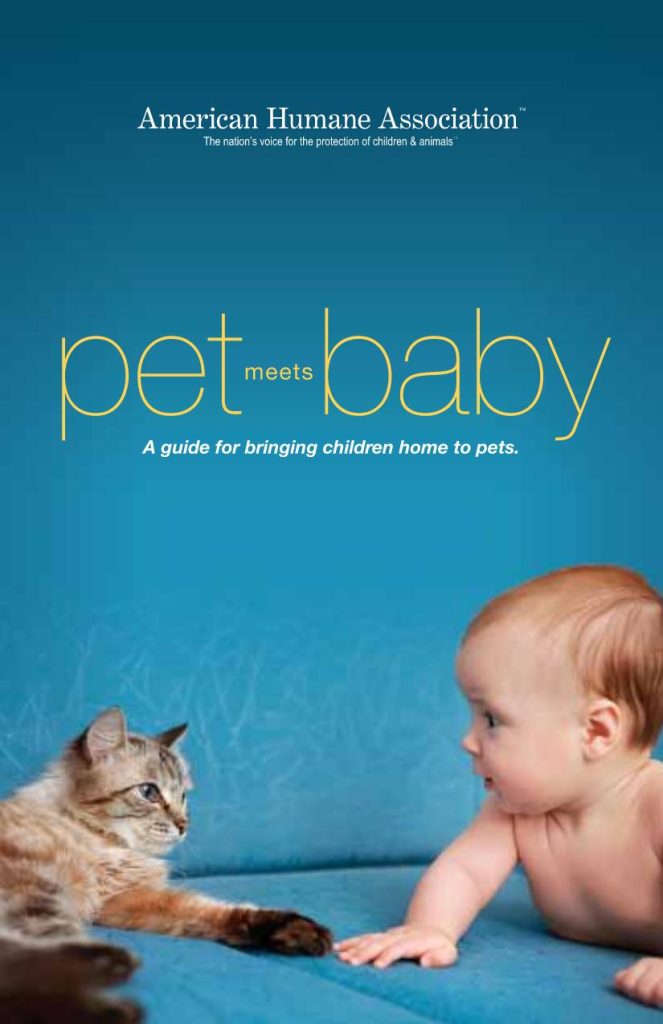

“Introducing a new baby to your family pet can be a beautiful thing — the bond that can develop between children and their pets is priceless if it is built on safe practices, mutual respect and love. Pet Meets Baby is a great resource I recommend to my clients, to make sure they know what to expect and how best to minimize the risks associated with introducing new family members— whether they have four legs or two.”
– Victoria Stilwell, national ambassador for
American Humane Association and star, “It’s Me or the Dog!”
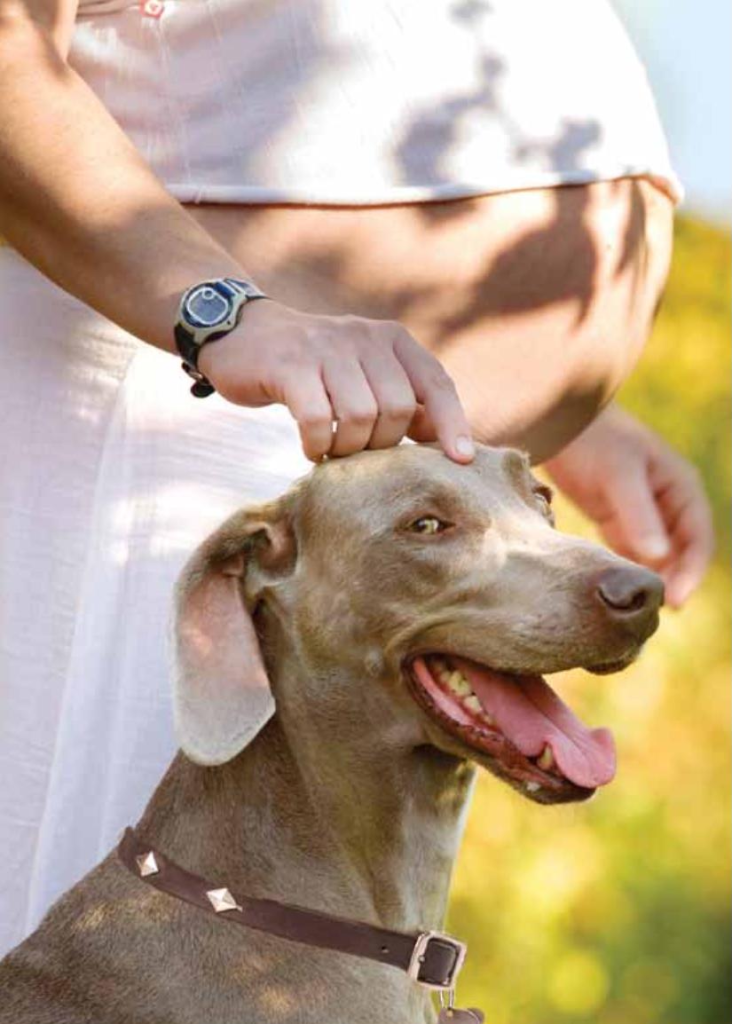
When you have a pet and you are bringing home a new child, via birth, adoption or fostering, there are a lot of factors to consider. The sooner you begin preparing your pet, the better your chances of success will be once the baby or child arrives.
You are already preparing your home, scheduling appointments and shopping for supplies—but keep in mind that it is also very important to prepare your pet. You may be able to wait until the last minute for some things, like selecting a color for the nursery or even deciding on the baby’s name, but you shouldn’t wait until the last minute to get your pet ready. Chances are, your pet needs time to adjust. And the longer you wait, the harder it will be for everyone. If you start right away, your chances of a smooth transition and safer interactions are much improved.
While this booklet primarily applies to dogs and cats, it also contains information about birds, fish, rabbits, rodents and reptiles. If you have any concerns about the behavior of your pet—whatever type of animal it is—be sure to contact a qualified professional as early as possible.
And remember, no matter how much you trust your pet, NEVER leave ANY baby or child unattended with ANY pet!
The material in this booklet is provided for general information only. Use this information at your own discretion. Any reliance on any information in this booklet is solely at your own risk. You are responsible and liable for the actions of your pets and children. The informa-tion set forth herein is not considered veterinary, medical, or other professional advice and is not intended to replace consultation with qualified professionals. We have done our best to make sure all internet addresses referenced herein were active when we published this booklet; however, American Humane Association has no control over, assumes no liability for, and cannot ensure the quality or accuracy of information on non-American Humane Association internet sites.
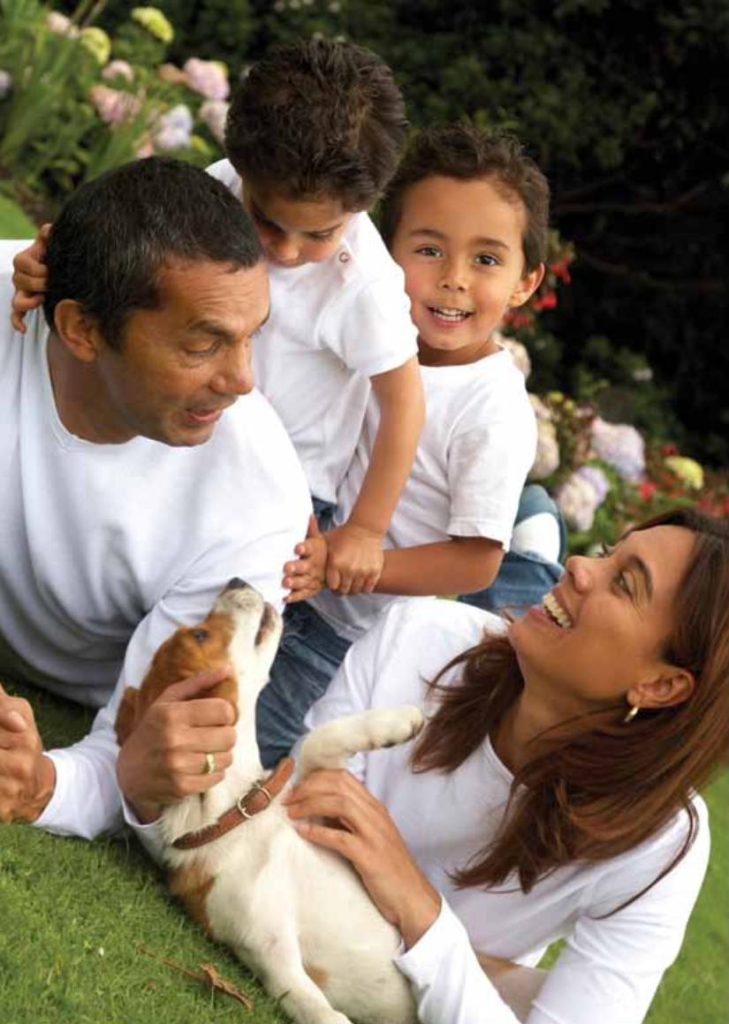
Contents
PREPARE AHEAD………………………………………………………………9
Modify attention and interactions
Desensitizing to the sound, sight and smell of the new arrival
Relocating your pet’s living quarters
Dogs in beds and on furniture
Relocating litter boxes
Appropriate knowledge of your pet’s species
Mental and physical exercise
Asking for help
ENSURE APPROPRIATE BEHAVIOR……………………………………. 19
Evaluate and train appropriate manners
Never punish warnings
Signs that your pet is stressed
What your pet is saying
THE BIG DAY……………………………………………………. 27
Pet meets new baby or toddler
Dog meets older child
Other pets meet older child
Visitor traffic
RAISING KIDS AROUND PETS…………………………………….. 31
Supervision
Appropriate interactions
Baby- and child-free zone
HEALTH AND DISEASE CONCERNS……………………………… 35
Dogs and toxocariasis
Reptiles and salmonella
Rodents and LCMV
Allergies
Gardening and sandboxes

Prepare Ahead
Modify attention and interactions
Despite your best intentions, when a baby or child arrives, your relationship with your pet will change. Chances are, your pet was your first “baby”—but soon a new person will arrive who requires your full attention.
Perhaps the most difficult change for pets is the decrease in physical and verbal contact. You may unconsciously pat your dog as you pass in the hallway, or talk to your cat while preparing dinner. But when the new member of your family arrives, your arms will be occupied more frequently, and you will spend more time talking to the baby or child. The result will be a decrease in unconscious attention to your pet. The attention is what your pet may miss the most, while you may not even be aware that anything changed.
Over the next few months, pay attention to how much “absent-minded” attention you give your pet, and make a conscious effort to gradually decrease it.
Also, try to implement your potential new schedule changes as early as possible, such as changes in your work and sleep schedules. At the same time, set aside regular productive quality interactions with your pet. The goal is to reduce the quantity of time and increase the quality of time. For example, do you think your pet would rather have a total of 30 minutes of random petting as you pass by, or 15 minutes of direct, one-on-one play time? If you do this slowly, your pet won’t even realize what happened, and if you do this before the baby or child arrives, no association between the baby or child and the change will be made.
Your pet will probably be excited that it is suddenly getting all of this quality attention, when in fact, it is getting less quantity.
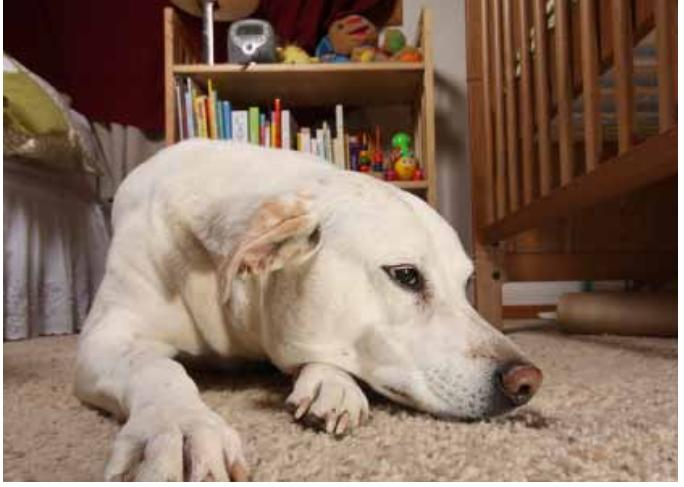
Additionally, as the baby or child’s arrival approaches, you will find yourself becoming busier and busier, and also more nervous or excited. Your pet can pick up on the changes in your activities and emotions, and you may begin to see your pet’s behavior change. Because of this, do your best to make any changes in your pet’s life as gradual and insignificant as possible. Also, try to be cognizant of how those changes affect your pet, and be on the lookout for behaviors that indicate your pet is stressed. (Refer to the section titled Ensure Appropriate Behavior.)
Desensitizing to the sound, sight and smell of the new arrival
If the arrival of a new baby or child in the home becomes unpleasant for the pet, the pet may directly associate that unpleasantness with the new arrival. You can avoid a negative association by introducing some of the changes before the baby or child arrives. If you see any questionable behavior, this gives you the opportunity to get help right away.
Sound
Begin by playing recordings of baby noises at a very low volume. As long as your pet is calm, non-anxious or curious, praise it as you gradually increase the volume. If your pet becomes anxious or fearful or displays any negative reaction, stop, turn the volume down and keep it at a level at which the pet is relaxed (you may have to try again the next day). Continually praise the pet at the lower volume until the
pet gets used to it, which may take several days or even weeks. Only increase the volume if your pet is relaxed and calm. Try moving the speaker, putting it in the crib or carrying it in your arms to desensitize your pet even more.
Sight
Get a realistic baby doll, preferably one that makes baby noises. Think of this as a “dry run” to evaluate how your pet may react, by holding and treating the doll like a real baby over and over (don’t leave it lying around). Encourage polite and calm investigation and reward your pet for good behavior. Gently correct moderately rough behavior, such as pawing, nibbling, mouthing or jumping, with a gentle “ahh ahh” and by encouraging appropriate behavior. Practice putting the doll in the crib, on the changing table, in the swing, in the car seat, or even take it for a walk in the stroller! Pets may find this new equipment unusual or even scary and, combined with a real baby, they may have a difficult time, so start early.
To desensitize your pet to children, this approach won’t work quite so well with a child-size doll. Instead, try desensitizing your pet by having children you know visit. With dogs, you can try walking past children at a safe distance, such as past a playground, schoolyard or athletic field. Be sure to not allow your dog anywhere near the children. Always treat and praise your dog every time it sees a child, but be sure to avoid rewarding it if it displays any negative reactions, such as fear, aggression or stress. If your pet reacts in any way you find questionable when around children, contact a professional trainer or behaviorist right away.
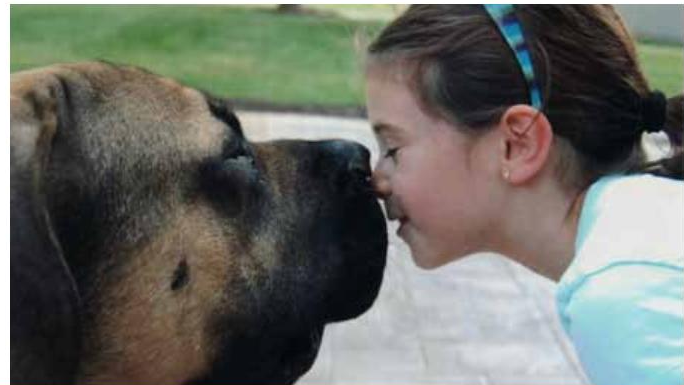
Smell
Smells are very intriguing to pets. Begin introducing your pet to the smells of the baby by rubbing on the doll the baby products you plan to use and letting the pet gently smell it. The pet may not care, or it may be overly curious.
When the baby is born, have a helper bring the baby’s cap home for the pet to investigate (a receiving blanket works almost as well). Be sure to not use the cap or blanket that is placed on the baby immediately after birth, as it will have blood and other overly stimulating smells. Instead, use an item that was placed on the baby after it was bathed, place it on the baby doll, and introduce it to your pet in a calm, controlled manner. Never let the pet take the doll or the item in its mouth — treat it like the real thing. If you are adopting or fostering a child, do your best to obtain a piece of clothing from the child. Let the pet smell it to its heart’s content, while you praise and encourage appropriate interactions.
If you begin desensitizing your pet early, you can address potential problems, help your pet gradually adjust and alleviate some of your own concerns. If your pet displays any behavior that concerns you, be sure to contact a professional
trainer or behaviorist right away. Do not ignore it — this is your opportunity to address it while you still can.
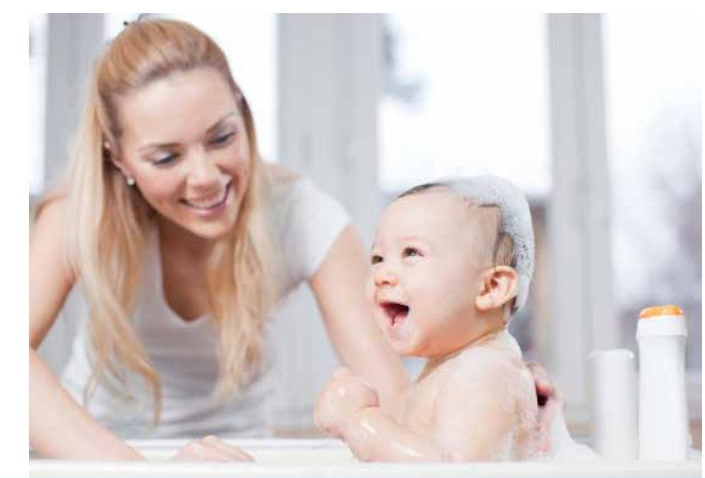
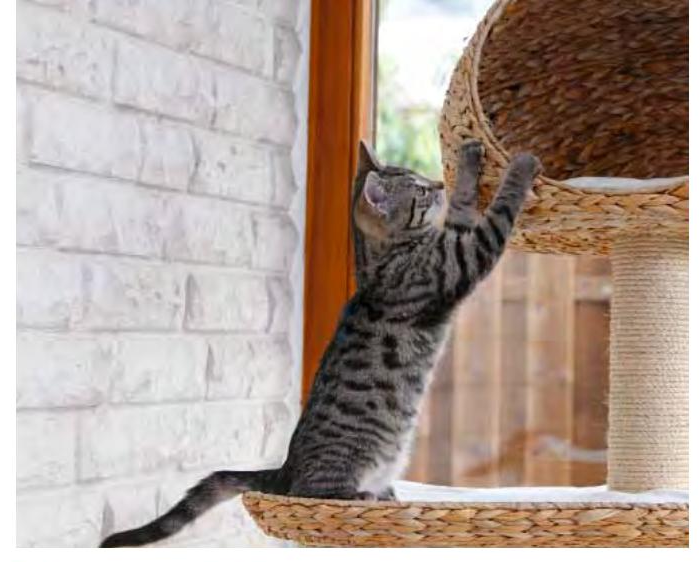
Relocating your pet’s living quarters
Many people keep crates, dishes or caged pets in a spare room, soon to be the nursery or child’s room. If you have to relocate your pet to make room for the new addition to your family, put serious thought into where and how you will
move the pet — and begin early.
For example, when moving a bird cage, avoid locations near windows and outside doors, which often are too drafty and can make birds sick. When moving a fish tank, avoid locations near windows, where temperatures fluctuate too much and
sunlight can cause an overgrowth of algae. Also, many pets, such as birds and rabbits, become extremely stressed in response to changes in their housing. If you have a pet that is sensitive to stress, make changes slowly or contact someone who specializes in your pet’s species for advice.
Many families wait too long and, when their pet doesn’t adapt, end up having to find it a new home or put it outside when the baby or child arrives. Keep in mind that domestic animals are not suited to living outside year-round in most climates. Also, dogs, cats and rabbits are social species that do not thrive in isolation. Please consider the physical and emotional health of your pet when making a transition.

Dogs in beds and on furniture
Being allowed on furniture and beds puts a dog at eye level with a baby or child, who the dog may perceive as a threat or as competition for resources: Some dogs see beds and furniture as property and become possessive of it. If your pet is
possessive of anything, be sure to seek help from a professional. Further, having a pet at eye level with a baby or child increases the chance of a bad experience— even a happy dog innocently jumping up may accidentally injure an infant.
Your best bet is to keep dogs off all beds and furniture, before the baby or child arrives. There will be nights when you bring your baby or child into bed with you, or you are changing the baby on the couch, or your toddler is eating a snack in the recliner. These are all situations in which an untrained dog may jump up and could accidentally cause injury. Do not expect an untrained dog to know it should not jump up on the bed when there is a baby lying there. Instead of waiting until after the baby or child arrives, prevent any potential for the dog to have negative associations with the baby or child by banning the dog from beds and furniture well in advance of the new arrival. By the time the baby or child arrives, you have eliminated potential danger and have a better-behaved dog. If you have difficulty implementing this, be sure to contact a professional.
Relocating litter boxes
If you have a cat or a rabbit that is litter-trained and you decide to move a litter box, be sure to begin moving it gradually, far in advance of the new arrival. Simply relocating the litter box days before the baby or child arrives may result in “surprises” on your carpet or couch. Instead, move the litter box no more than one foot per day, closer and closer to its final destination. While this may be an inconvenience in the interim, it will eliminate larger(and messier) inconveniences later on.
Here are some other tips that can help:
- Do not place litter boxes near noisy appliances,such as washers or refrigerators.
- Be sure to have one litter box on each level of multi-level homes, especially for elderly pets.
- Be sure to scoop every day and wash litter boxes once per week with a mild dish detergent (pregnant women should have someone else scoop the boxes —see the section on Health and Disease Concerns).
- Avoid deodorizers in or around litter boxes—these products may smell nice to you, but they are often a deterrent to pets.
- Avoid plastic liners, changing brands of litter and scented litter.
Appropriate knowledge of your pet’s species
Whether you have a dog, a rabbit, a snake or an iguana, make sure that you research how to properly care for your species of pet. Excellent resources can be found through the internet, libraries, special interest groups or by speaking to a veterinarian who specializes in the particular species. Many pets have very specific needs that you may be unaware of, as information changes over time. Also, commercial pet products may not be the best choice. For example, did you know that cedar chips are dangerous for all small animals and wood chips of any kind are dangerous for most small pets? Did you also know that many commercial foods are nutritionally imbalanced and some commercial treats are unhealthy for pets? We recommend that you research information about what your pet needs, as many species have different requirements. By searching reliable sources of information on the internet, speaking to a veterinarian who specializes in small animals or exotic pets,
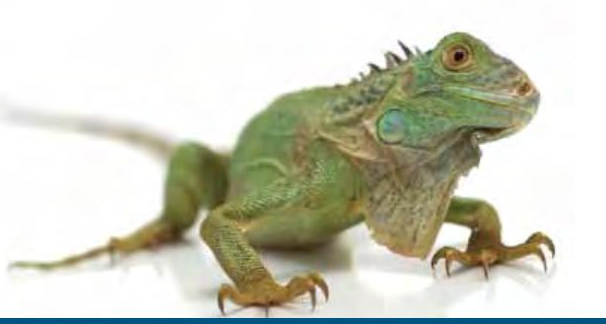
or contacting species-specific rescue organizations or your local animal shelter, you should be able to locate great information about the type of habitat, diet and other needs of your species of pet.
Mental and physical exercise
Like people, many pets can become bored quite easily. As the arrival date approaches, you will likely find you have less and less time to exercise and interact with your pet, and your pet may become confused. Pets that are frustrated, stressed or bored may engage in destructive behaviors (shredding the couch, chewing shoes, self over-grooming, feather plucking, etc.), house soiling, excessive vocalizations and more. Your pet may be trying to communicate to you: “I’m bored” or “I miss you.” Petsitters, dog walkers and doggy daycare are some examples of how you can still provide plenty of exercise for your pet. Enrolling in a training or agility class or joining a flyball or Frisbee group are other fun ideas. If you do not have facilities close by or cannot afford them, try enlisting the help of neighbors, friends or family.
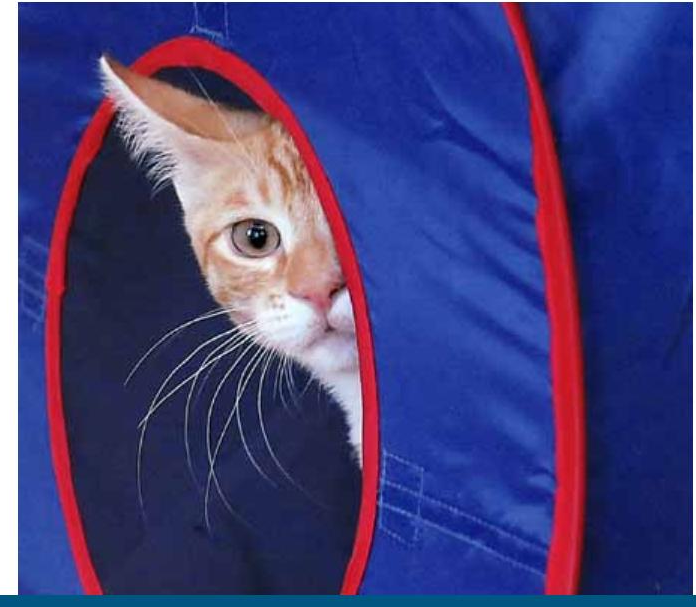
Another great way to entertain your pet is through the use of interactive toys. By putting tasty, healthy treats in toys, you can get your pet to engage in physically and mentally challenging activities. Almost all pets can benefit from interactive toys. For more ideas, see the resources in the “For more information” box. To prevent injury, be sure to always supervise pets while playing with toys.
Asking for help
Some people are alone when they are pregnant or adopting and may need help —with litter box cleaning, cleaning animal cages, and exercising and training pets —before the baby or child arrives. Also, while you are away, picking up the child or during the hospital stay, you may need a petsitter. Finally, right after giving birth, especially in the case of a Caesarean section, many women will need help caring for their pets. If you think you may need help at some point, don’t wait until the last minute. Begin early by enlisting a neighbor, friend, co-worker or family member to help with cleaning, exercise or training duties. You may also be able to hire help for some tasks. Begin far in advance, so your pet can get used to this new person. If you are new to an area, call around and find a reputable and insured petsitter. You can also contact your local humane society or animal shelter for references or suggestions.
For more information:
www.avianweb.com
www.parrotchronicles.com
www.parrotpages.com
www.parrottoy.com
www.parrotzoo.co.uk
www.tlcparrottoys.com
www.busybuddytoys.com
www.kongcompany.com
American Humane Association | Pet Meets Baby
www.petsitters.org
www.petsit.com
www.bunnybytes.com
www.rabbit.org
www.rabbitstop.com
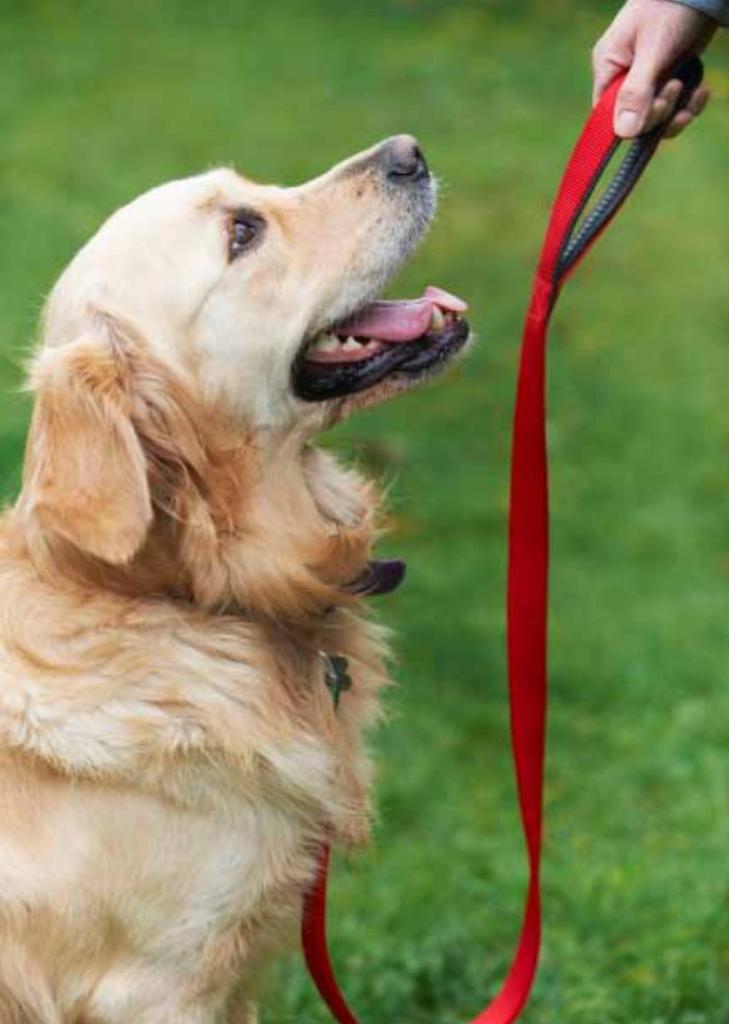
Never punish warnings
If your pet displays any negative behavior, such as growling, hissing or question- able body language, during any interaction with the baby or child (or the baby doll, when desensitizing the pet), be sure to never punish it. Your pet is letting you (and the baby or child) know it is uncomfortable, and it is communicating in a normal, natural and appropriate manner. Yelling at or correcting the pet will not make it adjust better. In fact, you may be teaching your pet that warning is a bad thing, and next time the pet may skip the warning and go straight to aggression. Warnings are good—they give you time to address the situation. Additionally, just because your pet reacted negatively to the baby or child does not necessarily mean you need to give the pet away; this may be an issue that can be remedied. Contact a professional trainer or behaviorist right away. Never attempt to address aggression or question- able behavior on your own.

Ensure Appropriate Behavior
Evaluate and train appropriate manners
When a baby or child is joining your family, it is important that your pet displays appropriate manners around family members—including other pets, guests and children—and amid distraction. Such behaviors must be in place far in advance of the arrival of the baby or child, so be sure to start early!
Certain behaviors may pose problems when the baby or child finally arrives. If you suspect there may be an area of concern when the child or baby arrives, you must address it as soon as possible, and professional help may be required.
Do not put it off, or the consequences could be serious: Your baby or child could get hurt or you may be forced to give up your pet. By starting the training early, you should have plenty of time to modify undesirable behaviors long before the baby or child arrives.
Below are just a few examples of pet behavior that
require immediate and early attention:
- Any form of aggressive behavior toward family members
- Any form of aggressive behavior toward other animals
- Rude behavior (such as snatching treats or toys, barreling through people, jumping up, door dashing, etc.). Rough play (such as using teeth or claws, grabbing clothing, etc.)
- Lack of training in commands such as sit, down, stay, off, come, etc.
Signs that your pet is stressed
When animals are stressed, they are more likely to feel the need to protect them-selves (“fight or flight” response). Just like if you are having a stressful day, you may snap at someone—it doesn’t mean you are a bad person, it just means you
are stressed. If you believe your pet is feeling stressed, anxious, nervous or fearful, make sure your baby or child is not near it. Also, babies and children should never be around any animal that is in heat, giving birth or with its young.
Give your pet some space and a quiet place. Also, be sure to identify the trigger of the stress, as it may be your baby or child. If this is the case, you should find a qualified behaviorist or trainer right away.
Signs your pet may be stressed:
- Panting or rapid breathing
- Pacing or excessive movement (frantic, escape behavior)
- Freezing or backing away (avoidance behavior)
- Charging forward, batting or snapping
- Dilated, large pupils
- Hunched, tucked-up body posture, silence (trying to become invisible)
- Fluffed fur or feathers, vocalizing, posturing, charging (trying to look intimidating)
Situations likely to cause a pet stress:
- Parties, holidays or other events where people gather with higher-than-normal excitement or activity
- Just prior to or during storms
- During veterinary exams, baths, nail trimming, etc.
- When sick or injured
- When eating or chewing on a bone or toy
- When in heat, giving birth or with its young
- Changes in household routines
More Information:
Finding a Veterinary Behaviorist: www.dacvb.org/resources/find
Finding a Behaviorist or Behavior Consultant:http://animalbehaviorsociety.org
ABSAppliedBehavior/caab-directory or www.iaabc.org,
click on “Find a Consultant”
Finding a trainer: http://www.apdt.com/petowners/ts/
Behavior problem tips:
www.ABRIOnline.org
www.apdt.com, click on “Pet Owners”
www.avsabonline.org
Suggested Reading
Scaredy Dog by Ali Brown (for fear-based dog and human aggression)
Mine! A Practical Guide to Resource Guarding in Dogs by Jean Donaldson
Feeling Outnumbered? How to Manage and Enjoy Your Multi-Dog Household by Karen London
Feisty Fido: Help for the Leash-Aggressive Dog by Patricia McConnell
I’ll Be Home Soon! How to Prevent and Treat Separation Anxiety by Patricia
McConnell
The Cautious Canine: How to Help Dogs Conquer Their Fears by Patricia
McConnell
How to Be the Leader of Your Pack…and Have Your Dog Love You for It
by Patricia McConnell
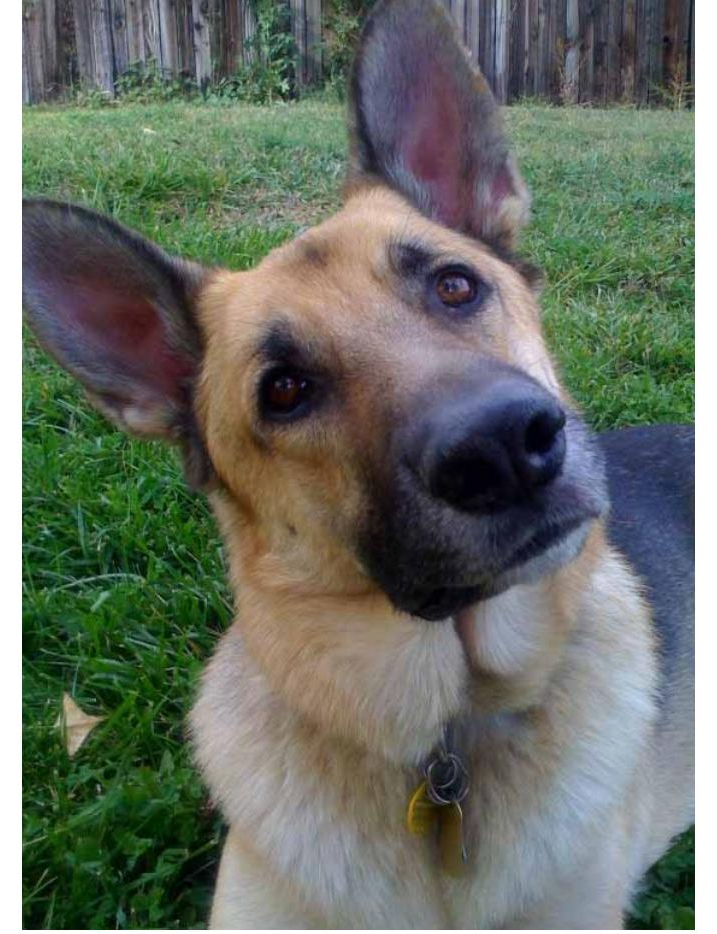
What is your pet saying?
Animals use “body language” to communicate and to express their emotional state. Understanding what your pet is “saying” can help you respond appropriately to your pet. The following illustrations identify key body language of cats, dogs and rabbits.
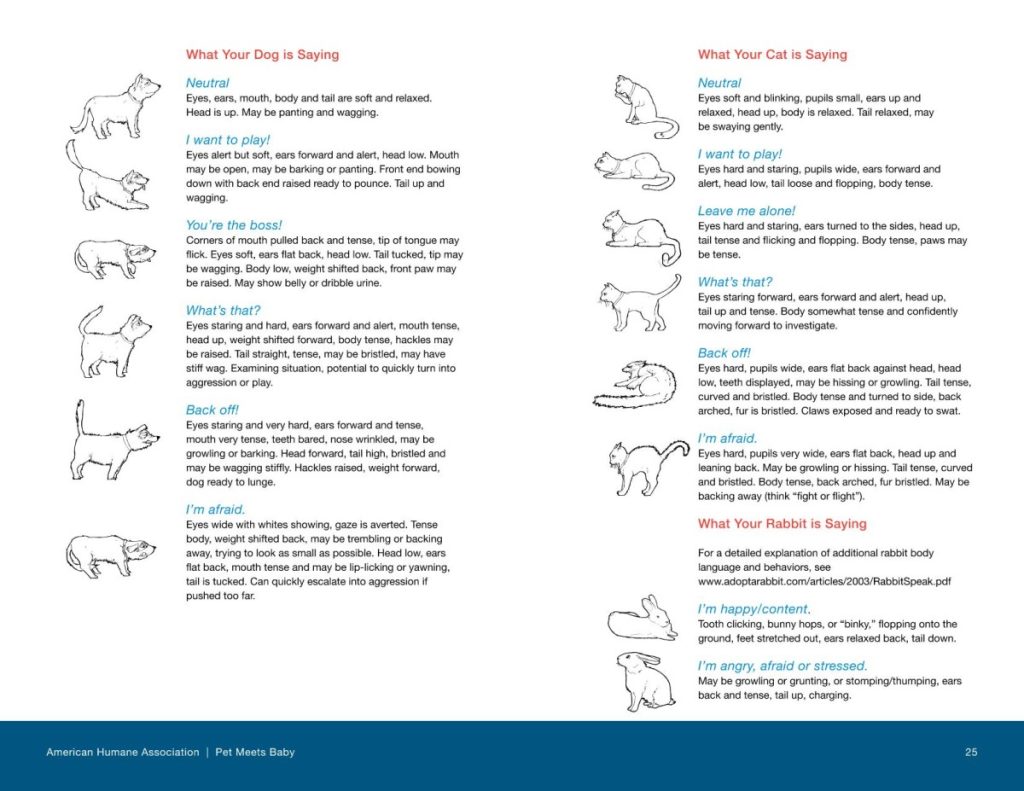
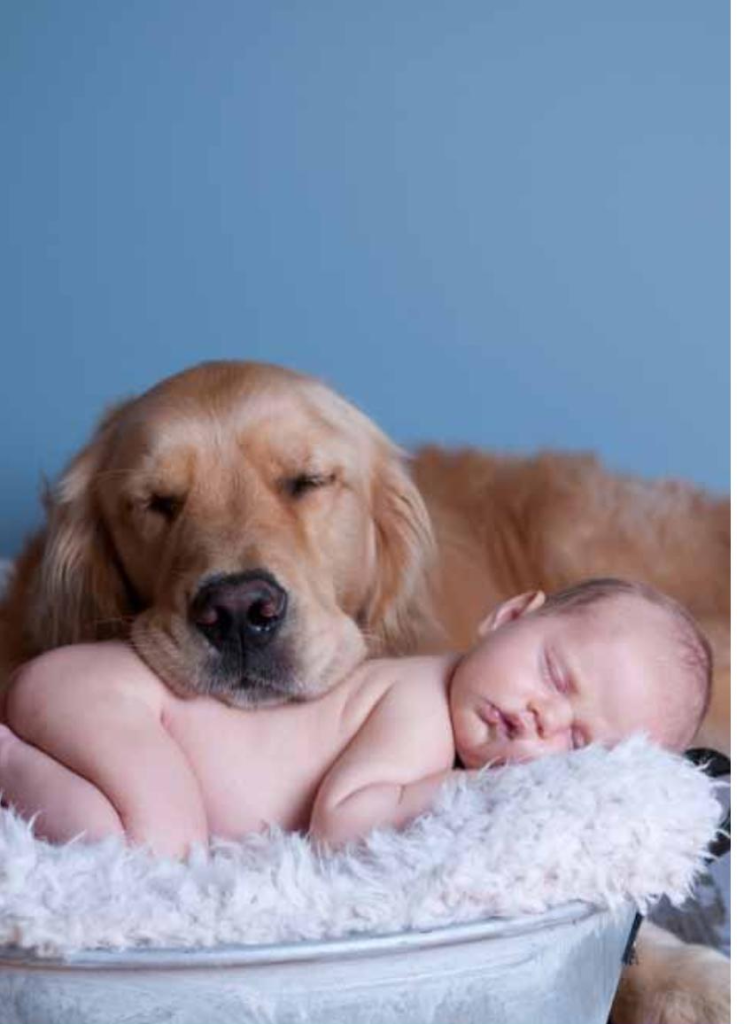
The Big Day
Congratulations! The big day has arrived. Whether a baby was born or a child has been adopted or you are a new foster parent, your pet’s first interaction is very important.
Have a helper who your pet is comfortable with, and welcomes, come to the house to exercise your pet prior to your arrival. When you get home, greet your pet while the baby or child waits with your partner, a friend or a family member somewhere outside the house. You may have been gone for a few days, so your pet will probably have missed you. Let the pet greet and smell you, especially if you have just given birth, as you will smell very interesting to it. Once the pet becomes thoroughly reacquainted with all the existing household members, it’s time to meet the new addition. Some pets may adjust quickly or ignore the new family member. However, if you are not sure how your pet will react, the following are some suggestions for introducing your pet to your new baby or child.
Pet meets new baby or toddler
Ask your helper to carry the baby or toddler into the house in his or her arms (not in the car seat) while you stay with your pet. If you have a dog, you may want to put it on a leash. If you prefer to hold the baby or toddler at this point,
the handoff can be made. Multiple pets should meet the baby or toddler one at a time, and you or your helper (household member, friend or relative) should encourage happy, relaxed greetings from the pet while gently correcting any rough or forceful behavior with a verbal “ahh ahh.” If your pet displays any questionable behavior, remove the baby or toddler—not the pet—from the area (do not punish the pet!) and try again later. If your pet displays aggression at any time, contact a professional right away.
Dog meets older child
If you have adopted or are fostering an older child and you have a dog, your best course of action is to have them meet outside of the home, weather permitting. After you have reacquainted, take your dog outside on a leash walk. Have the child and your helper join you and continue the walk until the novelty of the dog has worn off for the child and the dog has adjusted to the child’s presence. Have the child toss some treats to the dog. If you have more than one dog, they should meet the child one at a time. If weather does not permit an outdoor greeting, you willhave to let them meet indoors. Make sure it is in a large, open room and have the dog on a leash.
Other pets meet older child
If the pet is interested, encourage polite greetings from both parties. If the pet is hesitant or nervous, encourage the child to ignore the pet and go do something else (such as investigate the home, go see his or her new room, have a snack, etc.) to allow time for the pet to adjust—at its own pace—and the novelty of the pet to wear off for the child. The child and pet should be kept separate until the pet is ready for interaction. Small children should not be allowed to hold small pets unassisted. With any pet, if you allow an over-enthusiastic child to greet an unwilling pet, the chances of success are greatly decreased. Once the pet has adjusted, ask the child to sit calmly while you introduce the pet. If you encounter any questionable behavior from the pet, contact a professional right away.
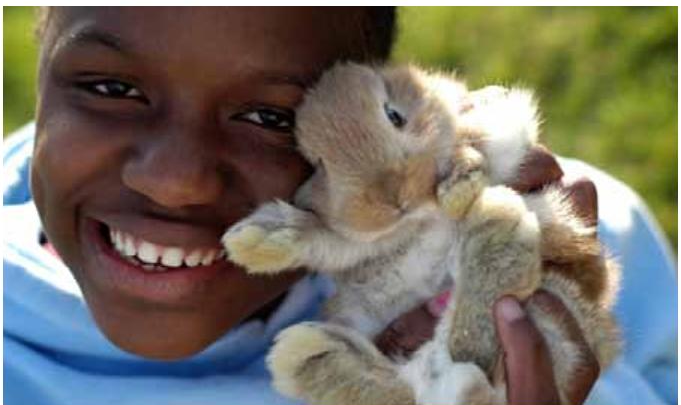
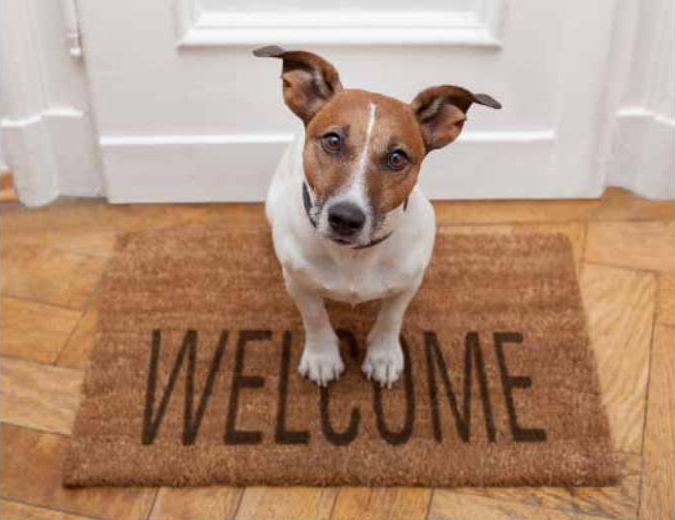
Visitor traffic
When a new baby or child joins your family, everyone you know may come to visit, and it may be as if your house suddenly has a revolving door. Make sure your pet is not a “door dasher” and is not aggressive toward guests. You may need assistance with this, but training should occur well before the baby or child arrives.
Alert guests to the presence of pets right away by placing a sign on your entry doors to bring their attention to the pet on the other side. The sign could say something like, “Please don’t let the cat get out.” Keep in mind that excited guests may become distracted, so be sure to always secure the doors shut. Ask guests to greet social pets, especially dogs, before greeting the baby or child. A pat on the head and a biscuit will usually do the trick, and it allows the pets to get their greeting out of the way. (You may wish to keep hand sanitizer around for guests to use before they touch a baby.)
If you have pets such as rabbits and/or birds that wander your home, be sure they are accounted for before the door opens — especially skittish rabbits and birds with unclipped wings. Put these pets in their enclosures to keep them safe when you know company is on the way.
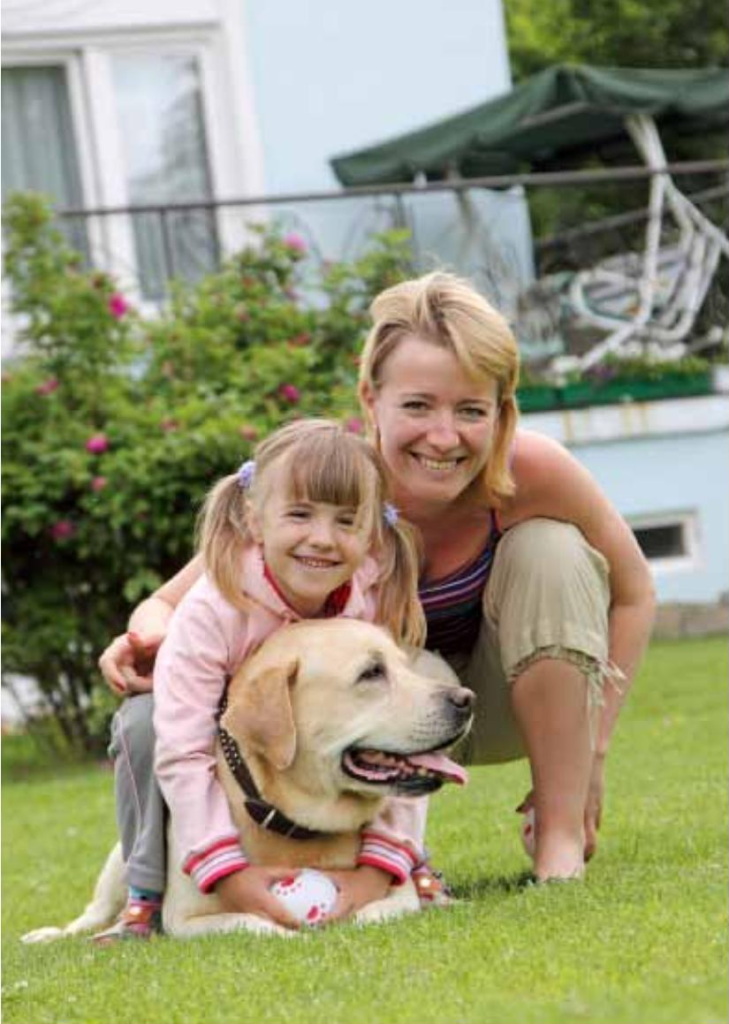
Raising Kids around Pets
By properly preparing ahead with your pet, you should have a smooth and enjoyable transition when bringing home your new member of the family. The next step is making sure daily life together is just as enjoyable for both your pet and your baby or child.
Supervision
The majority of dog-related fatalities and animal bites to children occur as a result of unsupervised or inappropriate interactions. Children should not be trusted around pets—regardless of the species—and pets should not be trusted around children. Adult supervision is crucial to ensuring safety.
It is normal for an animal to become curious about a newborn, as it looks, sounds and smells unusual, and many animals investigate new things with their paws or mouth. Animals do not recognize newborns as members of the family, or even
as humans. Dogs and cats are predators, and it is normal for them to react to small creatures that move and sound unusual. This does not mean you necessarily have to give up your pet. Proper supervision and diligence will eliminate dangers in most situations.
Always play it safe—no “ifs, ands or buts”:
But my dog is small—he won’t bother the baby.
In October 2000, a 6-week-old baby was killed by her family’s Pomeranian when her caretaker left the room to prepare a bottle. 1 This does not mean that all Pomeranians are dangerous or that the caretaker was negligent — it means a dog is a dog, regardless of size, and the potential for injury exists.
But the baby is in the crib, she will be safe.
Some dogs and most cats can get into cribs, and the nets that fit over cribs aren’t pet-proof. The potential for investigatory bites, accidental scratches or predatory aggression poses too big a risk. Ban all pets from the nursery unless an adult is there to supervise.
But I’ll only be gone for a second.
A bite only takes a second and, for a newborn, even a nip can be fatal. For a child, a bite to the face can leave emotional scars that last a lifetime. Even if you leave the room for only a second, remove either the baby/child or the pet from the scenario.
But my pet is a therapy pet—I trust her with the baby.
Animals are animals, period. It doesn’t matter how much you trust your pet or how well-trained your pet is. Investigatory bites can be fatal. Also, aggression is a natural, normal behavior, and any animal may engage in aggression if it feels threatened or confused.
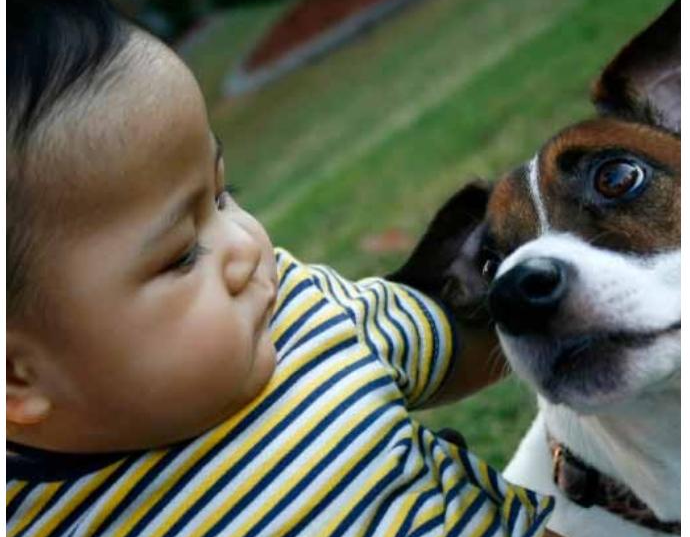
Appropriate interactions
Your baby or child will likely be very interested in your pet. In fact, most children’s first words are related to pets or animals. Your child may want to grab or chase your pet, but you must not allow those actions. Just like you don’t allow your pet to have free access to your child, your child must be supervised and taught to behave properly around pets. Grabbing, chasing, pulling or other investigatory behaviors on your child’s part, while completely normal, are not appropriate.
Begin by teaching your child how to properly approach and touch your pet: calmly, quietly and gently. Your pet should not be expected to tolerate shouting or grabbing, so if your child becomes overly excited, remove your child from the situation and try again another time. Both your pet and your child should learn that interactions can be fun and rewarding, not scary and painful!
Also, be sure to teach your child proper bite prevention.
Children should leave pets alone during the following times:
- When pets are sleeping (whisper to wake pets up)
- While pets are eating or chewing on bones or toys
- When pets are in heat, giving birth or with their young
- When pets are stressed, sick or injured
- When pets are tethered, in a fenced area, in a car, in a crate, etc.
- When no adults are around
- In hot weather
Baby-and child-free zone
Be sure to provide your pet with a baby- and child-free zone. The pet should have a calm, quiet spot where it can go and never be bothered by a baby or child. It is important to teach your child that this location is off-limits.
For more information:
American Humane KIDS: Kids Interacting with Dogs Safely Your Dog and Your Baby: A Practical Guide by Silvia Hartmann-Kent Child-Proofing Your Dog: A Complete Guide to Preparing Your Dog for the Children in Your Life by Brian Kilcommons and Sarah Wilson Your Baby and Bowser by Stephen C. Rafe
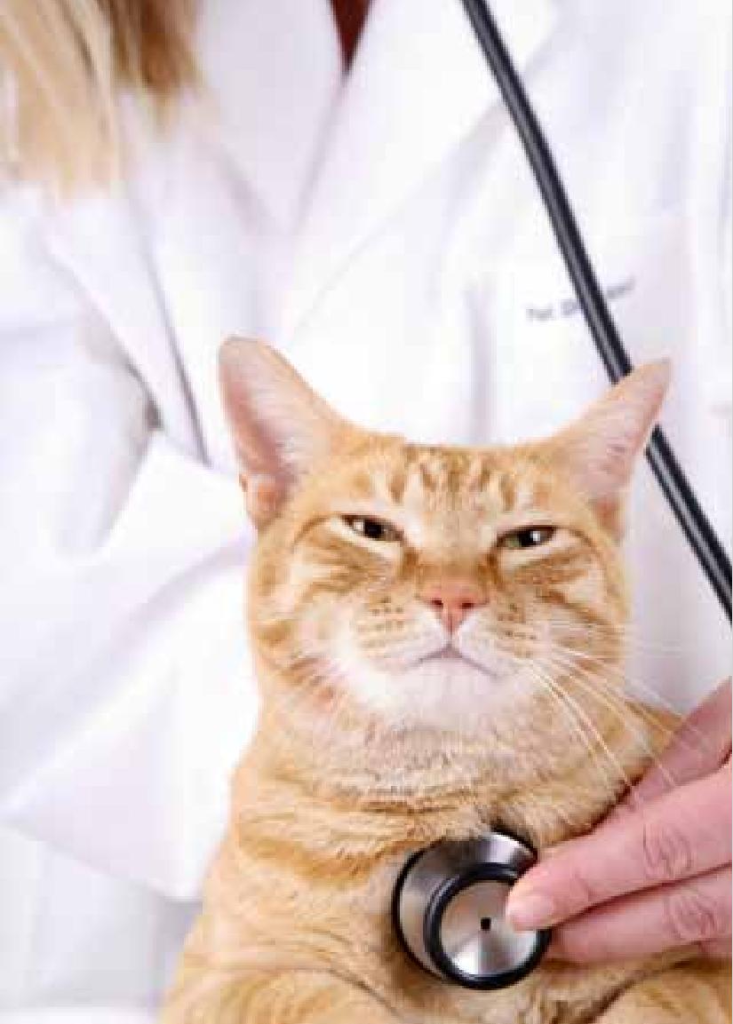
Health and Disease Concerns
Schedule a complete exam for your pet to ensure that it is healthy inside and out and is up-to-date on all vaccinations. Be sure your pet is free of internal and external parasites, such as worms, fleas, ticks and mites. Be aware that some external treatments could be toxic to your child. Fecal exams, heartworm tests, dewormers, and flea and tick preventive treatment may be needed. Also, be sure to address any sore spots that may cause pain to your pet—such as hot spots, injuries, arthritis, etc. When a child touches your pet in a spot that causes pain, it is normal for the pet to react.
Please read through all of the following health concerns. While you may not own one of the species listed, your friends or family may and, therefore, the information may apply to you, your pregnancy and your baby or child.
For more information:
www.avma.org
www.cdc.gov/healthypets
Cats and toxoplasmosis 2
Toxoplasmosis is a parasitic disease that can be transmitted by ingesting infected cat feces, consuming raw or undercooked infected meat, or ingesting contaminated water. To acquire the disease, a cat must consume raw meat or live animals that are infected with toxoplasmosis. Once infected, the cat can spread the disease for only a few weeks. Further, the contaminated feces must remain in the litter box for five days, and then be ingested by the pregnant woman to be infective. According to the Centers for Disease Control and Prevention, people who have toxoplasmosis may feel as if they have the flu with swollen lymph glands or muscle aches and pains
2www.cdc.gov/toxoplasmosis
that last a month or more. Severe toxoplasmosis can cause damage to the brain, eyes or other organs—infants born to mothers who are newly infected during or just before pregnancy are among those most likely to develop severe toxoplasmosis.As scary as this disease may sound, there is no need to give up your cat! To prevent exposure to toxoplasmosis, give the job of cleaning the litter box to another family member. If you do not have someone to help you, here are some suggestions:
- Prevent your cat’s exposure to infected rodents by keeping it indoors.
- Wear rubber gloves and a mask when cleaning the litter box.
- Scoop the litter box daily and put feces directly into the toilet.
- Wash or sanitize hands often—and immediately after scooping.
- Freeze meat for a few days and cook thoroughly.
- Peel and wash all fruits and vegetables.
- Sanitize cutting boards, counters, utensils and hands after contact with meat . or unwashed fruits and veggies.
- Wear gloves to garden, and wash hands after gardening.
Dogs and toxocariasis 3
Toxocariasis is the presence of roundworm larvae in human tissue. Roundworm parasites are commonly found in domestic animals, especially dogs, and the eggs are excreted through the host animal’s feces. Infection can occur in humans when roundworm eggs are ingested through ingestion of dirt, unwashed vegetables, etc. The eggs then hatch and the larvae move throughout the body. Symptoms can include inflammation of the eyes, fever, cough, asthma or pneumonia.
The best ways to prevent exposure to toxocariasis are:
- Deworm dogs and cats.
- Wash hands after playing with pets or handling feces or dirt.
- Do not allow children to play near areas where animals have defecated.
- Clean pets’ living areas weekly.
- Dispose of pet feces by bagging or burying it.
Reptiles and salmonella 4
Salmonella are bacteria found in the digestive tracts of most animals, especially reptiles. Salmonella can be transmitted through ingestion of animal feces via contaminated fruit, vegetables, and raw or undercooked meat and eggs. Failure to wash your hands after handling a reptile or before eating also can transmit salmonella. When ingested by humans, salmonella can cause diarrhea, fever and abdominal cramps and may require hospitalization. Salmonella exposure can be very serious to infants, the elderly and people who are immune-compromised.Following these suggestions can reduce your chances of infection:• Wash hands after handling pets and/or their equipment.
- Wash hands, cutting boards, counters and utensils after preparing fruits and vegetables, raw meat or raw eggs.
- Avoid eating raw or undercooked meats and eggs and unpasteurized dairy products.
- Thoroughly wash fruits and vegetables.
- Wash hands after using the bathroom.
- Use a solution of 25 percent bleach and 75 percent water to clean areas where reptiles live and their equipment.
- Never let children bathe in the same place as reptiles, which can leave behind salmonella.
- Don’t let reptiles roam freely, unless you sanitize surfaces they have contact ..with (also, find out if your friends’ reptiles wander their homes).
- Prevent mouth-to-mouth transmission — don’t kiss your reptiles.

Rodents and LCMV 5,6
Lymphocytic choriomeningitis virus (LCMV) is an infection carried and transmitted by wild rodents. The virus can be transmitted when infected rodents come in contact with pet rodents, either before or after purchase. In rare cases, humans can contract LCMV through unsanitary handling of an infected animal’s urine, feces or blood; through a bite; or through inhalation of dust or droplets while sweeping droppings. During pregnancy, LCMV can result in fetal damage, defects and loss of pregnancy.These concerns do not necessarily mean you have to give up your pet rodent, as there are many options for reducing the chance of exposure. Infection among humans almost always involves house mice, and rarely involves pet hamsters.
These practices can reduce your chance of infection:
- Address rodent infestations in the home.
- If you are pregnant, avoid sweeping or vacuuming rodent droppings, urine or nest materials by asking someone else to do it for you.
- If you are pregnant, stay away from pet rodents or ask a friend or relative to care for them during your pregnancy.
- Wash hands after handling rodents and their equipment.
- Do not kiss pet rodents or hold them close to your face.
- Clean supplies with a solution of 25 percent bleach and 75 percent water.
- Keep cages clean at all times and free of soiled bedding.
- Clean cages outdoors, or at least in a well-ventilated area.
- Be sure your rodent pets are not exposed to wild mice or rats.
5 www.cdc.gov/ncidod/dvrd/spb/mnpages/dispages/lcmv.htm
6 www.cdc.gov/healthypets/lcmv_rodents.htm
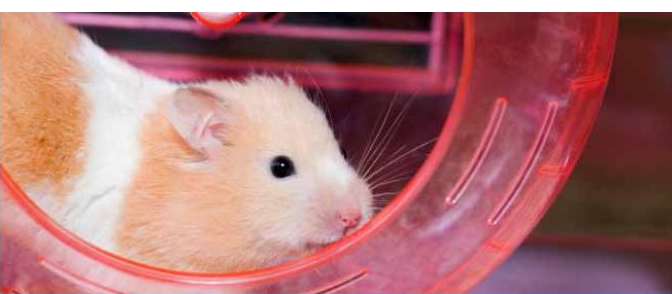
Allergies 7,8,9
If you are concerned that your pet may cause your child to develop allergies, don’t give up your pet just yet. One study found that infants who live in homes with multiple dogs are two times less likely to develop wheezing.
Another study found that exposure to pets at home may protect children from developing pet allergies until at least age 7. Other studies have found that children without pet allergies and newborns who live with pets are less at risk for allergies, eczema and asthma. Among children with other, non-pet related allergies, having pets does not seem to make the situation worse. However, among children with pet allergies, having pets may exacerbate symptoms.
So, what can you do? It is recommended that pet owners wait to see if a child develops allergies, then test to determine if a pet is the cause. If your child does have pet allergies, and also has asthma, it is recommended that the pet be removed from the household.
Gardening and sandboxes
Gardens and sandboxes are like public toilets for strays and wildlife, and they can harbor diseases and parasites. (See the sections above on Cats and Toxoplasmosis and Dogs and Toxocariasis.)
If you garden while pregnant, you may be exposed to the contaminated feces of stray cats or wildlife. Always wear waterproof gloves while gardening, and sanitize your hands thoroughly immediately after gardening, as well as before eating or drinking.
If you have a sandbox, make sure it’s always covered when not in use. After your child plays in dirt or sandboxes, be sure to sanitize his or her hands thoroughly, especially before eating.
7 webmd.com/parenting/baby/news/20050321/pet-dogs-may-keep-infants-from-wheezing
8 www.webmd.com/allergies/news/20070101/pets-may-protect-children-allergies
9 www.webmd.com/allergies/cats_dogs_allergies_asthma
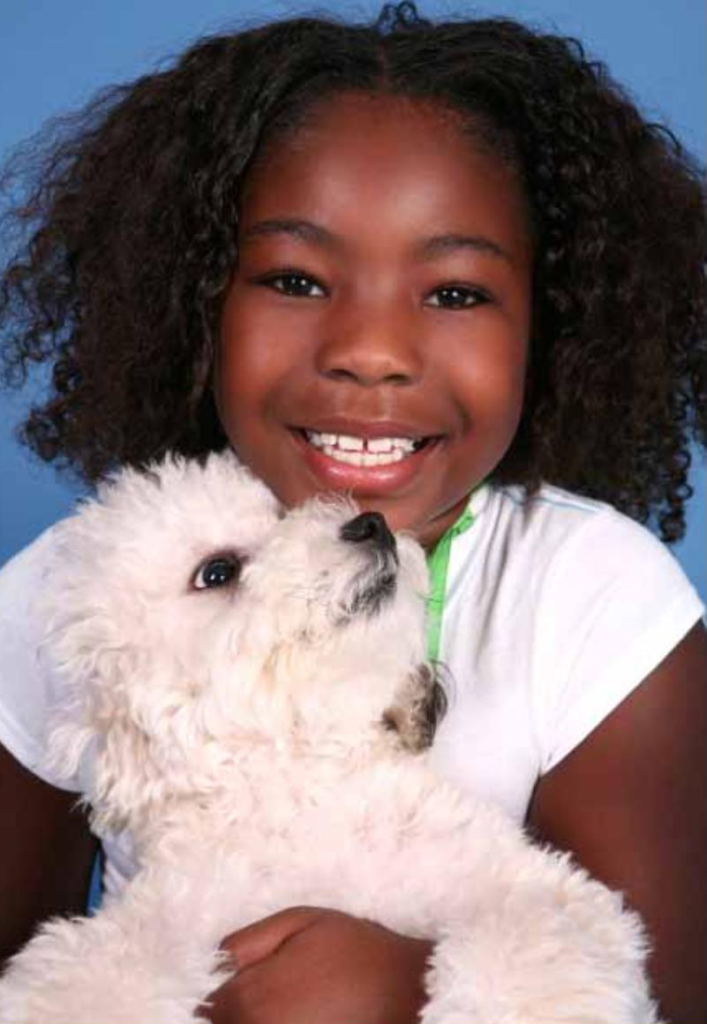
The Basics
Before the Baby Arrives
- Make sure pets have appropriate manners and training well in advance.
- Identify and address any questionable behavior; assistance from a professional may be required.
- Train dogs to stay off people’s beds and furniture.
- Introduce schedule changes well in advance.
- Make sure pets are healthy, inside and out.
- Be sure to understand relevant disease and health concerns and take proper safety precautions.
- Get pets used to the sight, sound and smell of the new arrival.
- Relocate litter boxes or pet cages, if necessary, as early as possible.
- Have complete knowledge of and provide for pets’ physical and mental needs.
The Big Day
- Bring home the baby’s cap, blanket or clothing (or, if a child, an article of the child’s clothing) and allow the pets to smell the item thoroughly.
- Have a helper at home to exercise cats and dogs before you arrive.
- Have a helper take the baby or child and stay outside while the parents reacquaint with their pets.
- Have a helper bring the baby or child into the house for an introduction to the pets.
Safe Kids, Happy Pets
- NEVER leave ANY baby or child alone with ANY pet.
- Teach appropriate manners to children.
- Keep babies and children away from stressed pets.
- Establish a baby- and child-free zone for your pets.
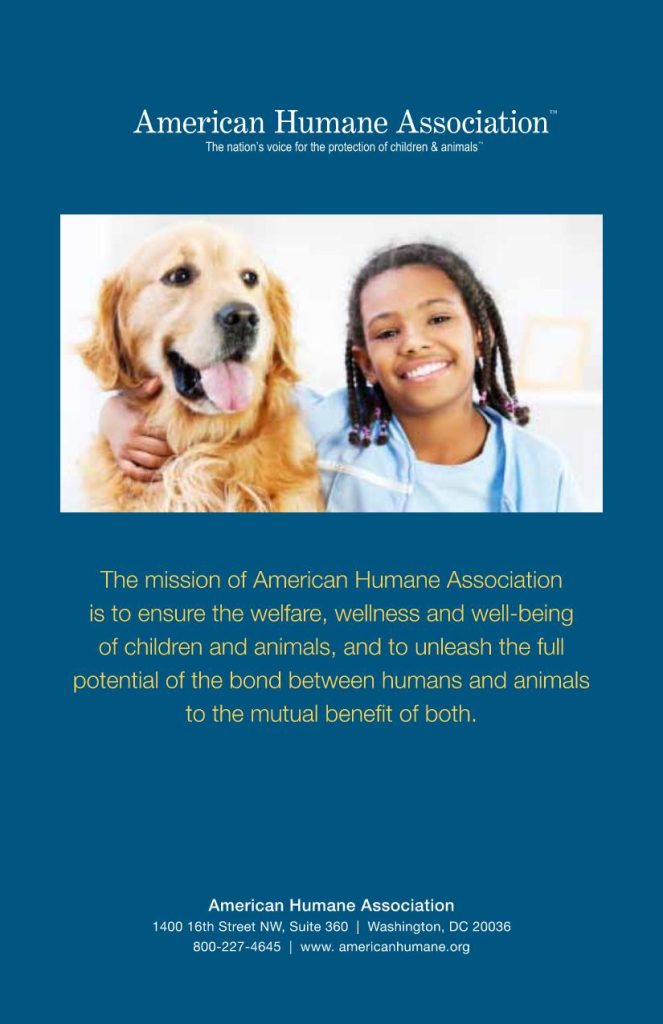
Need help? Call our free pet behavior help line at (503) 416-2983.
We also offer Private Training Classes for you and your pet. Click here for more information.


